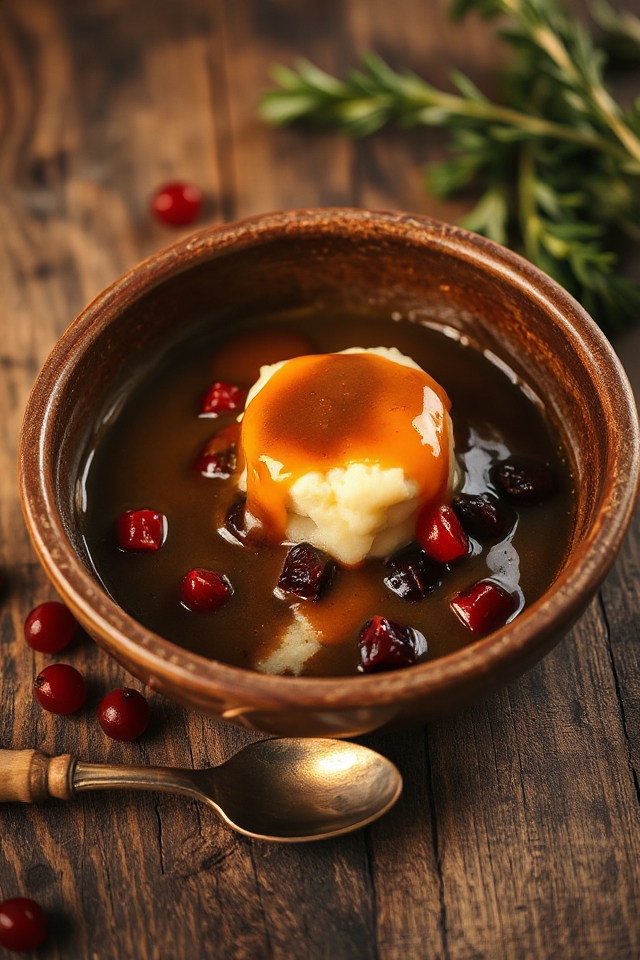Why You’ll Love This Homemade Gravy Recipe
You’ll love this homemade gravy recipe for its rich flavor and simplicity. I can’t tell you how many times I’ve whipped this up in no time, and it always impresses my family and friends.
The aroma fills the kitchen, making everyone excited to dig in. I appreciate how versatile it is, complementing everything from roasted meats to mashed potatoes.
Plus, you don’t need fancy ingredients or techniques—just the drippings from your cooked meat and a few staples. It’s a comforting addition to any meal, and once you try it, you’ll wonder how you ever lived without it!
Ingredients of Homemade Gravy
When it comes to making homemade gravy, the ingredients play a vital role in achieving that mouthwatering flavor we all crave. Fortunately, you don’t need a long list of complex items—just a handful of staples and some delicious drippings from your cooked meat.
With these simple components, you’ll be on your way to whipping up a luscious sauce that can elevate any meal. So, roll up your sleeves, and let’s gather what you need to create this delightful addition to your dinner table.
Ingredients for Homemade Gravy:
- Juices from cooked meat
- 2 heaping tablespoons of flour
- Water or vegetable stock
- A dash of red wine
- 1 tablespoon of red currant jelly
- Salt and pepper, to taste
Now, let’s talk about those ingredients. The juices from cooked meat are where the magic begins. They carry all the rich flavors from your roast, turkey, or whatever meaty delight you’ve prepared.
If you’re a vegetarian or just want a lighter option, vegetable stock works wonders too. Flour is your thickening agent, so don’t skip it unless you want a soupy mess.
And the red wine? It adds depth and sophistication, but if you’re not a fan, you can leave it out or substitute with more stock.
Finally, the red currant jelly might seem a bit quirky, but trust me—it gives your gravy a sweet, tangy twist that perfectly balances out the savory notes.
How to Make Homemade Gravy

Alright, let’s plunge into the delicious world of making homemade gravy. It’s simpler than you might think, and trust me, once you get the hang of it, you’ll want to drizzle it on everything. So, roll up those sleeves and let’s get to work.
First things first, grab the juices from your cooked meat. This could be from a roast chicken, a juicy steak, or even a holiday turkey. Pour those glorious drippings into a saucepan.
Now, take 2 heaping tablespoons of flour and sprinkle it right into the pan. Don’t just dump it in and run away—give it a good stir for about a minute. We want to cook that flour a bit so your gravy doesn’t taste like raw dough. It should start to look a little thicker and more cohesive—like it’s ready for its close-up.
Next, it’s time to add some liquid gold. Pour in water or vegetable stock, whichever you prefer. Start with about a cup and stir well to avoid those pesky lumps that can sneak in when you’re not looking. Just keep stirring until it’s nice and smooth.
Now, let’s add a dash of red wine for depth—think of it as the secret agent in your gravy, making everything a little more sophisticated. If you’re not a wine person, no problem; just add a bit more stock instead.
And don’t forget that tablespoon of red currant jelly. It might sound odd, but it’s like adding a sprinkle of magic—sweet, tangy, and oh-so-delicious. Finally, season with salt and pepper to taste. Give it a taste test—maybe you’ll need a little more salt or a smidge more jelly, depending on your mood.
And there you have it! Homemade gravy that could make even the most mundane meal feel like a feast. Just remember, the key is to adjust it to your liking. Who knew gravy could be this easy?
Now, go ahead and pour it over mashed potatoes, biscuits, or whatever your heart desires. Your dinner table is about to get an upgrade.
Homemade Gravy Substitutions & Variations
While making homemade gravy is a delightful process, experimenting with substitutions and variations can take your culinary skills to the next level.
For a richer flavor, try using chicken or vegetable stock instead of water. If you’re aiming for a gluten-free option, cornstarch works wonders as a thickener.
I love adding a splash of soy sauce for umami or a dollop of mustard for tang. You can swap out red wine for balsamic vinegar or omit it entirely for a simpler taste.
Don’t hesitate to incorporate fresh herbs like thyme or rosemary to elevate your gravy’s profile even further!
What to Serve with Homemade Gravy
Homemade gravy pairs beautifully with a variety of dishes, enhancing their flavors and bringing comfort to any meal.
I love serving it over mashed potatoes, where it seeps into every fluffy bite. It’s also perfect on roasted meats like turkey or beef, adding richness that’s hard to resist.
For a cozy breakfast, try it over biscuits—it’s a classic that never disappoints.
Don’t forget about veggies; drizzling gravy on steamed broccoli or green beans elevates them to a whole new level.
Whatever you choose, homemade gravy will surely make your meal feel special and satisfying. Enjoy!
Additional Tips & Notes
To guarantee your gravy turns out perfectly every time, I recommend keeping a few tips in mind. First, make sure your flour is fully incorporated; it helps avoid lumps.
If your gravy’s too thick, gradually add more stock or water until you reach the desired consistency. For added depth, experiment with different types of stock or a splash of balsamic vinegar.
Taste as you go and adjust seasoning accordingly. Finally, if you want a richer flavor, don’t hesitate to add a bit more red currant jelly or a hint of Worcestershire sauce.
Enjoy your delicious, homemade gravy!